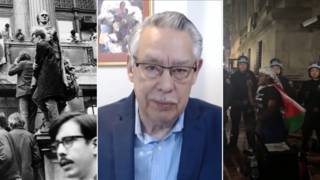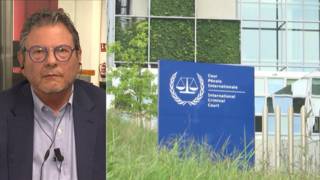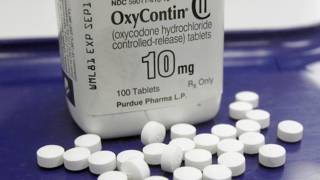
Related
Topics
Guests
- Christopher Glazekinvestigative reporter.
- Ed Bischfather of Eddie Bisch, who died of an OxyContin-related overdose in 2001 at age 18, and founder of Relatives Against Purdue Pharma.
The Sackler family, the billionaire owners of OxyContin maker Purdue Pharma, have secured immunity from all current and future civil litigation related to their role in fueling the opioid epidemic. The legal shield was granted last week by a federal appeals court in exchange for the family agreeing to pay up to $6 billion to thousands of plaintiffs in various lawsuits that are now suspended as part of the deal. While the Sacklers appear safe from further civil litigation, they could — and should — be criminally charged, says Ed Bisch, who lost his son Eddie to an OxyContin-related overdose in 2001 at age 18. “Fines without any prosecutions, there is no deterrent. They look at it as the cost of doing business,” says Bisch. We also speak to Christopher Glazek, the investigative reporter who was the first to publicly report how the Sackler family had significantly profited from selling OxyContin while fully aware that the highly addictive drug was directly fueling the opioid epidemic in America. “The Sacklers lied about how addictive the drug was, in order to convince doctors and patients that it wasn’t dangerous,” says Glazek.
Transcript
AMY GOODMAN: This is Democracy Now!, democracynow.org. I’m Amy Goodman.
We turn now to the opioid epidemic, which has killed over half a million people in the United States over the last 20 years. Last week, a federal appeals court granted members of the billionaire Sackler family immunity from all current and future civil litigation related to their role in creating and fueling the opioid epidemic. The Sacklers are the owners of Purdue Pharma, which makes OxyContin, the drug many say helped fuel the opioid epidemic. In exchange for civil liability, the Sacklers have agreed to pay a $6 billion settlement out over some 18 years. But due to the terms of the settlement, the Sacklers are expected to keep much of their fortune.
We turn now to Part 2 of our conversation with Ed Bisch, the founder of RAPP, Relatives Against Purdue Pharma. He formed the group after his 18-year-old son Eddie died of an OxyContin-related overdose in 2001. But first, we go to investigative reporter Christopher Glazek. He wrote the first article in 2017 documenting how the Sacklers were profiting from the highly addictive drug. I asked Christopher Glazek to talk more about who the Sacklers are.
CHRISTOPHER GLAZEK: The Sacklers, you know, have been one of the richest families in the United States for decades. You know, they first got super rich in the ’60s, actually with a different drug, with Valium. And, you know, their billions and billions came in the ’90s with OxyContin.
And what the Sacklers have always been really, really good at is selling a highly addictive drug, often a deadly drug, in the case of OxyContin, and they’ve been really, really good at getting doctors to prescribe this addictive drug for an enormous universe of patients. So, originally, they had this other drug, basically the same as OxyContin, except it was morphine instead of oxycodone. And that originally was just for cancer patients. And that was in the '80s. And people kind of figured, “OK, if you have terminally — terminal cancer, who cares if you get addicted? You're going to die. We don’t really care what happens in the last year of your life.” Well, what the Sacklers did, when that drug ran out of patent, they said, “What if we took basically the same drug, and instead of targeting it at cancer patients, we targeted it at any patient who had any kind of pain? It could be a toothache. It could be menstrual pain. It could be back pain. It could be a headache. And what if we said, 'This isn't something just for terminally ill patients or for temporary pain. This is for life’?” Someone could be an OxyContin for the rest of their life because they deal with some kind of chronic pain.
And then, the problem, as it turned out, was that you build tolerance to OxyContin. So, in order to get the same effects, you have to increase your dose more and more each time. We have evidence of the Sacklers in board meetings saying, “We need to make sure doctors are prescribing the highest possible doses.” And they wanted to do that because that was how they made the most money. They made money per volume. And so we see the Sacklers, as individuals, repeatedly, over years, saying, “We need to increase the doses. We need to increase the doses.”
AMY GOODMAN: Now, of course, they could say, “Well, it’s doctors who are prescribing this drug. We simply make the drug. Why are we responsible?” Explain how the whole system worked, and how the PR and the lobbying fit together with the science and the making of the drug.
CHRISTOPHER GLAZEK: It’s very interesting. The Sacklers were real pioneers in the field of pharmaceutical advertising. And the patriarch of the family is actually the first inductee in what is called the Pharmaceutical Advertising Hall of Fame. And what he learned is that doctors, like ordinary people, are very susceptible to forms of advertising. The first insight he had is, if you take out an ad in a prestigious medical journal, like a print ad, and you have it right next to these, you know, academic studies, that people take that ad really seriously. The doctors think that it counts for something. But that wasn’t the only thing they did. They also, effectively, bribed doctors. They had these organizations that would fly doctors out to Pebble Beach or fancy beach locations. And maybe the doctor would give a talk, and they’d give them a thousand bucks and this free trip.
They had this really elaborate, complicated system of kickbacks that targeted every link in the chain — government regulators; pharmacies; patients got rebates on their first prescription, which is kind of like a drug dealer giving you a freebie that gets you hooked; and then the doctors themselves had all kinds of incentives that were thrown their way. So, the Sacklers have been very, very adept, from the beginning, at targeting every person in the chain, that gets from factory to patient, and making sure that they all get their kickback, which keeps the system and the cycle going.
AMY GOODMAN: I’d like to go back to the 1998 Purdue Pharma marketing video.
PURDUE PHARMA MARKETING VIDEO: Once you’ve found the right doctor and have told him or her about your pain, don’t be afraid to take what they give you. Often, it will be an opioid medication. Some patients may be afraid of taking opioids because they’re perceived as too strong or addictive. But that is far from actual fact. Less than 1% of patients taking opioids actually become addicted. And any drowsiness that might occur when you start to take the medication will soon wear off in most patients.
AMY GOODMAN: This was procured by STAT, the medical publication showing that ad. So, we could see how Purdue Pharma marketed themselves. Only 1% — or, they say less than 1% of patients get addicted, Chris. Can you talk about that?
CHRISTOPHER GLAZEK: So, that is nonsense and is built on these faulty studies, many of which aren’t even studies. I mean, one of the things that the Sacklers would cite, there was like a letter to the editor in a journal, like in a — that, you know, suggested in some very weird group of population of patients that the rate of addiction was super low. But it’s total nonsense. It’s a lie.
And the Sacklers lied about how addictive the drug was, in order to convince doctors and patients that it wasn’t dangerous, because there was actually a lot of fear of opioids in the '90s, you know, coming out of the heroin epidemic in the ’70s and ’80s, and the Sacklers set out to change the brand of opioids. And they undertook this really concerted, elaborate process. They created these kind of astroturf, kind of fake patient groups to launch what was called the pain movement. And they essentially rebranded opioids and pain relief as a kind of sacred human right that everyone should have access to. Now, people should have access to pain relief, and I wouldn't contest that. But the Sacklers, what they really wanted to do is they wanted to get rid of this fear of opioids. They called it opiophobia. And then they called the addiction threat pseudoaddiction. And they were actually very effective at getting people to kind of break down their fear over what opioids could do.
Of course, as it turns out, those fears were really, really well founded. And what we now know, after a couple studies have been done — people ask, “OK, well, how important were the Sacklers really? This was one company. Didn’t other pharmaceutical companies get involved?” And it’s really important to understand that Purdue Pharma and the Sacklers built this market. And we can see, even today, there are studies that have gone back and seen the places in the country where the Sacklers put the most marketing dollars. And we can see that, 20 years later, those places still have more deaths, more addiction than neighboring states, which previously had been, you know, maybe the same. But we see that once the Sacklers got to town and deployed their armies of sales reps, that those places, even 20 years later, have much higher rates of addiction and death.
AMY GOODMAN: Which brings us to Ed Bisch. I just showed that Purdue Pharma marketing video from 1998. Ed that was three years before Eddie, your 18-year-old son, died in 2001. Can you tell us Eddie’s story?
ED BISCH: Yes. So, Eddie was in — he was a high school senior, normal kid. The first time I heard the word “OxyContin,” my son was in his bed, dead. That’s the very first time I heard the word “OxyContin.” OK? That was in February of ’01.
In August of '01 was the very first congressional hearing on OxyContin. I went to that hearing, not really knowing, you know, Purdue's story. And at that hearing, the congressman grilled the Purdue exec, and he said — well, this was in Philadelphia, and there was a pill mill doctor flooding Philadelphia with pills. And he told the Purdue exec, “You knew exactly, through IMS data, how many pills this doctor was putting on the street. Why didn’t you contact authorities?” Well, he started mumbling something. Then his lawyer jumped in, and he gave some legalese answer, but not really a valid answer.
And that’s when I first started having a bad feeling, because up until that point, my mission was just to warn kids about OxyContin. But as I slowly learned more through newspaper articles and talking to patients who got addicted, or talking to family members whose relative died after they were prescribed it — 2003, there were so many parents I was talking to, we got to do something. And I saw a picture in the paper of three moms, stood outside of Purdue Pharma with posters of their dead kids. And I said, “That’s a great idea.” I went out of my way. I contacted one of the moms. I said, “OK.” We got a tip. Purdue was having a seminar in Florida, Orlando, Florida, a lavish resort. And about 20 of us parents all over the country, we decided to do something. And we said, “We got to give ourselves a name. What are we going to call ourselves?” We came up with RAPP, Relatives Against Purdue Pharma. So we held the second protest. This was in 2003.
So, nothing much changed, except the death count kept on going up. As more and more Oxy sales went up, more and more deaths. 2001, there was 14,000 deaths. Last year, there was over 100,000 deaths. I watched this thing mushroom.
2007, I was allowed to give a victim statement at the Purdue Pharma trial. We didn’t know, and the judge — the judge was apologetic to us, that he wanted to give them jail time, but he says, “The guidelines. I have to go by the guidelines.” What he didn’t know, there was a 120-page prosecution memo calling for felony charges, that the very top of the DOJ sat on, 120 pages. There’s a six-page summary summarizing that. That 120-page memo is still under seal. Painkiller comes out August 10th. This was also covered in Dopesick on Hulu, but Painkiller, I have high hopes, and I know it’s going to be good. And so, that’s 2007. If that memo wasn’t buried, we would — we wouldn’t have 100,000 deaths.
It is the pills that are fueling the opioid epidemic, which is now a fentanyl poison epidemic. But kids, you know — like Chris said, they changed medical thinking. There were so many pills on the street. Kids are kids. Unfortunately, they experiment, and they try this Oxy. It makes them feel good. They don’t know the hell that they’re going to face. And some of them don’t face hell, they just die. And that’s what happened to my son. But if that 120-page memo wasn’t buried…
So, they pleaded guilty to a felony in 2007. In 2020, they pleaded guilty to three more felonies for almost the exact same thing. Again, they just pay a fine. You know, fines without any prosecutions, there is no deterrent. They look at it as the cost of doing business. Punishable by fine means legal for a price.
AMY GOODMAN: I mean —
ED BISCH: So, and the sad thing is, other companies saw what Purdue got away with, and they emulated them.
AMY GOODMAN: Ed, you clearly have had an enormous effect. New York Times article I’m looking at, headlined “The Four Ordinary People Who Took On Big Pharma.” And in that, it talks about how, first, you wanted to believe the excuses, Purdue’s excuses. You were even persuaded to change the name of your message board to “Oxy Abuse Kills.” Explain what that was all about — you used to call it “Oxy Kills” — and then the offer that Purdue Pharma made to you and your group, RAPP, Relatives Against Purdue Pharma.
ED BISCH: OK. So, my son died on a Monday. That Sunday, I was on a TV show, talk show in Philadelphia, where I’m at now. And after the show, I had three people — before that, I had started a little message board. After the show, three people offered to build me a website. I took the first caller up on him, and I called it “Oxy Kills.”
All a sudden, I’m getting all these emails from irate pain patients, telling me — some of them are nasty, saying my son deserved to die, and people like my son are stopping them from getting the medicine they need. And I was shocked. And I would, you know, try to reason with some of them and, you know, explain, “Look, I just want to warn kids not to abuse this drug, because it’ll kill them.”
About three weeks in, I get an email from someone at Purdue Pharma. And it was very cordial. And they said, “We want you to know our drug’s great, if properly used.” I had no reason to doubt that. It’s FDA-approved, right? So, you know, we went back and forth, and it was very cordial. But they were very defensive. Any time I would bring up any news story, or I heard from this patient who got addicted, you know, they told me less than 1% of people get addicted. I heard all their lines.
And, you know, it wasn’t until August, when I went to that congressional hearing, I started to sense something. But at the time, you know, I was getting flooded with these emails from chronic pain patients. So, anyway, Purdue made me an offer. They said, “If you ever want to do anything with prescription drug abuse, let us know,” because they know — they knew I was going around with the Philadelphia Police Department and talking at high schools, and I talked at my son’s high school. And, you know, so I decided, I said, “OK.” I said, “I’ll change” — you know, it was my idea, because I didn’t know exactly why all these people were so irate. Here, I found out a lot of the pain organizations, that Purdue funded, actually got their members fired up. And, you know, that was causing a lot of this trouble. And the story that patients couldn’t get their drugs, well, sales kept on going up and up.
So, to make a long story short, I went up to Purdue Pharma, and I met with the medical director, J. David Haddox. And, you know, I said, “OK, I’m going to change my — you know, for a small donation, I’m going to — which will help me buy a laptop” — which was very expensive back then, and software to give presentations on my own, because the Philadelphia police would give me five minutes to talk about pills. And pills were the latest thing, and that’s what killed my son, so I wanted to talk a lot more about them. So, anyway, when I went up there, I said, “The only thing that’s bothering me is I’m getting a lot of emails from people who got prescribed Oxy and then got addicted, or I’m hearing from their relatives, and they’re dead after being prescribed.” And he said to me — he looked at me right in my face, and he says, he says, “Well, less than 1% of people get addicted, so they must have been doing something wrong.” He says, “And all these stories are really, really stopping patients from getting the pills, you know, the drug that they need.” I said, “Oh, so sales are down?” He looked me in the face. He says, “Yes, a lot.”
So, I went away, and I started my program, and I felt really uneasy then. Three months later, I almost fell off my chair. Headline in the paper, “OxyContin Sales Up 24% in the Last Year.” I knew right then and there that I was being played, and the country was being played. And then I’m really starting to investigate. And like I said, you know, that’s it. That was around 2003. And, you know, we formed RAPP. And we did that first protest, which was the second one against them. We went to FDA hearings. We went to trials. We did a couple more protests. A lot of RAPP members got to speak at the 2007 hearing — or, not hearing, sentencing. And like I say, we didn’t know — we didn’t know about that 120-page memo. We really didn’t know about the Sacklers, because they hid themselves. It wasn’t ’til Chris came out with his article that the world really realized how hands-on and involved the Sacklers were.
And, you know, it’s just — I don’t have regrets about that. But I’m sure — I pray the people who sat on that memo and didn’t allow justice back in 2007, because there’s so many more people now addicted or dead who should never have been dead — and like I said, a lot of mistakes were made in the past, but the DOJ can make amends by doing the right thing. Just follow the money. Follow the evidence you have in your possession. There’s been over 10 books written about this. 2003, Painkiller, the very first book, 2003. 2001, the very first hearing, congressional hearing, on Oxy deaths. The evidence is there. Just use it. Do your job.
AMY GOODMAN: So, I want to turn —
ED BISCH: And that’s what I pray for.
AMY GOODMAN: I want to turn to the level of activism that has really turned this story around, or, I should say, exposed it, that you were a part of, Ed Bisch. Let’s turn to the trailer of the documentary film directed by Laura Poitras called All the Beauty and the Bloodshed. The film follows the renowned artist Nan Goldin and her activism to hold the Sackler family accountable for their role in fueling the opioid crisis.
PATRICK RADDEN KEEFE: There’s the Sackler family, of the art world, the museum world and philanthropy. And then there’s the Big Pharma marketing and addiction and death.
NAN GOLDIN: My anger at the Sackler family, it’s personal. When you think of the profit off people’s pain, you can only be furious.
NOEMI BONAZZI: Nan said, “I think we should take these people down. But do you think my career will implode?” And I said, “Probably.”
NAN GOLDIN: We need to demand that the Met Museum, the Louvre, the Tate refuse donations from the Sacklers and take down their name.
AMY GOODMAN: So, that’s a clip from All the Beauty and the Bloodshed. I wanted to bring Christopher Glazek back into this conversation, as you talked about activism turning this around. Talk about who Nan Goldin is, and the impact not only of Nan and Ed Bisch, but so many thousands of people who decided that the courts were not enough, that the legal system wasn’t going to do it, and what they did.
CHRISTOPHER GLAZEK: Yeah. So, I mean, it’s really interesting, in particular, what Nan Goldin was able to accomplish in the art world. So, Nan is a legendary photographer from the '70s and ’80s. She herself developed an addiction to opioids, which really put a stop to her career for a while. And, you know, she basically read my article, that was in Esquire, and then another article in The New Yorker that came out a couple weeks later, and she got incensed. She had never heard of the Sacklers. She had heard a little bit about Purdue, and she knew that OxyContin was the thing that hooked her, but she didn't know that there was actually a single family behind it.
So, you know, at that time, in late 2017, there was a lot of media attention around this. But as I said, you know, that burst of media attention did not convince the major museums or institutions to cut links with the Sacklers. They all said, “This isn’t really our business. We don’t know where the money comes from. The Sacklers never told us where it came from. And, you know, we would prefer to stay out of this.”
Well, then Nan starts doing these really high-profile actions in museums, like she went to the Met, to the Temple of Dendur, had hundreds of people come throwing prescription bottles with messages on them. She did another action in the Guggenheim, you know, and she had experience also from AIDS activism, taking cues from ACT UP. She knew how to make a media spectacle, and she got a lot of people’s attention in the art world that way. And because Nan herself was a famous artist, she was also able to threaten to pull out of shows, remove her work from museums. And she really forced those museum directors to get serious about starting to take down the name, which was hard for them, because they had contracts with the Sacklers. It wasn’t like so straightforward to take down the name. But she really held their feet to the fire.
You know, there’s been activism, obviously, from families and individuals stretching back to the early 2000s. Ed was a part of that. And, you know, what that — you know, and that activism did result in something. It resulted in this prosecution in 2007, where executives at the company, three of them, did actually have to plead guilty to misdemeanor charges. But they were kind of the fall guys. You know, the name that never came up anywhere in that trial, and as Ed has said, he wasn’t even really aware of, was the name Sackler, because the Sacklers made sure that their name was scrubbed. There was this, you know, other kind of side deal agreement, a nonprosecution agreement from 2007, in which the Sacklers were exempted from any kind of prosecution, so — which is important to point out also with this question now: Could the Sacklers be prosecuted? Well, they can’t be prosecuted for anything before 2007, because the government already agreed to make them immune for that. So it would have to be something later than 2007, although there’s plenty of crimes since then.
Nan started this groundswell in the art world. And you kind of, you know, over time, started to see the dominoes falling — the Louvre in Paris, the Guggenheim, the Met. You know, in the U.K., it’s taken a little bit longer, but now we’ve started to see action there also.
The academe really was a lot slower. And something that just interested me, that surprised me, we never had a Nan Goldin medical professor. There’s all these medical schools all over the world that have Sackler in their name, whether it’s the whole school or an institute or an endowed chair. And you never had any of these professors raise a stink about, “Hey, you know, should we really — we’re professional healers. Should we really be taking this Sackler money?”
And I think that what Nan Goldin’s example teaches us is that it really just takes one person with influence in a professional world, and they can really accomplish a lot. Just, you know, her example is so inspirational. The movie that just came out is amazing, All the Beauty and the Bloodshed. You know, I would hope that more people would kind of take from that example. Didn’t really happen in the academe up to now. But, you know, I’m hopeful that there will be further movement there.
AMY GOODMAN: I want to go to another clip from Laura Poitras’s remarkable documentary, All the Beauty and the Bloodshed. In this clip, you hear a 911 call played during a court hearing where the Sacklers were forced to listen to the families of the victims.
KRISTY NELSON: [screaming] No! My son!
911 DISPATCHER: They’re already on the way. They’ve already been dispatched.
JUDGE BILL NELSON: Thank you.
911 DISPATCHER: Has he taken anything?
JUDGE BILL NELSON: We don’t know. He has in the past.
911 DISPATCHER: OK.
KRISTY NELSON: Oh my god! Why? Why?
MEGAN KAPLER: Oh my god.
JUDGE BILL NELSON: Do you need me on the line anymore, sir?
911 DISPATCHER: You said he’s 20 years old?
JUDGE BILL NELSON: Yes.
911 DISPATCHER: What’s the name?
JUDGE BILL NELSON: Pardon me?
911 DISPATCHER: What’s his name?
JUDGE BILL NELSON: Bryan Fentz, F-E-N-T-Z.
911 DISPATCHER: OK. We’re on our way. OK?
JUDGE BILL NELSON: Thank you, sir.
KRISTY NELSON: Four thousand eight hundred and four days. Richard, if you’re still listening, that’s how many days since I have made that horrifying call. I have lived with the pain and heartache as a result of the loss of my only child, a pain you will never understand.
JUDGE BILL NELSON: I can only echo the pain and suffering that Kristy feels and that all of us that are here today feel. I want to point out to the Sacklers that by the time this two-hour hearing is over, we can add 16 more people to your death list.
AMY GOODMAN: Christopher Glazek, if you could describe what we just watched and listened to? We’re talking about a court hearing where the Sacklers had to listen to this with family members hearing their own 911 call of hysteria, losing a loved one. The significance of this moment? Again, that was from Laura Poitras’s All the Beauty and the Bloodshed.
CHRISTOPHER GLAZEK: It’s been this decades-long struggle for accountability to force the Sacklers to appear in public to answer to the victims. And this was a stipulation of one of the agreements, that the Sacklers had to send the representatives of the family, and they had to hear the victims talking directly to their face, something they had not done in 20 years, as they built the largest pharmaceutical fortune in history from this deadly drug.
AMY GOODMAN: And in the last minute we have, we give that minute to Ed Bisch. Here we are in 2023. Your final message to the world?
ED BISCH: 2023, please, Public Citizen has a letter to the DOJ. You can just sign your name, send them an email. I was also able to give testimony at that. Richard Sackler would not show his face. That’s how much of a coward he is. OK? But he had to listen. He had to watch us. And I think it was 20-some — 20-plus of us gave him hell. Did he care? I doubt it. But it felt good. And I’m proud to say that lady who you just heard, Kristy Nelson, she is now a member of RAPP.
AMY GOODMAN: Ed Bisch, founder of RAPP, Relatives Against Purdue Pharma. He formed the group after his 18-year-old son Eddie died of an OxyContin-related overdose in 2001. Thanks also to investigative reporter Christopher Glazek, who spoke to us from Mexico City. In 2017, he wrote a piece for Esquire headlined “The Secretive Family Making Billions From the Opioid Crisis.”
To see Part 1 of our discussion, go to democracynow.org. I’m Amy Goodman. Thanks for joining us.











Media Options